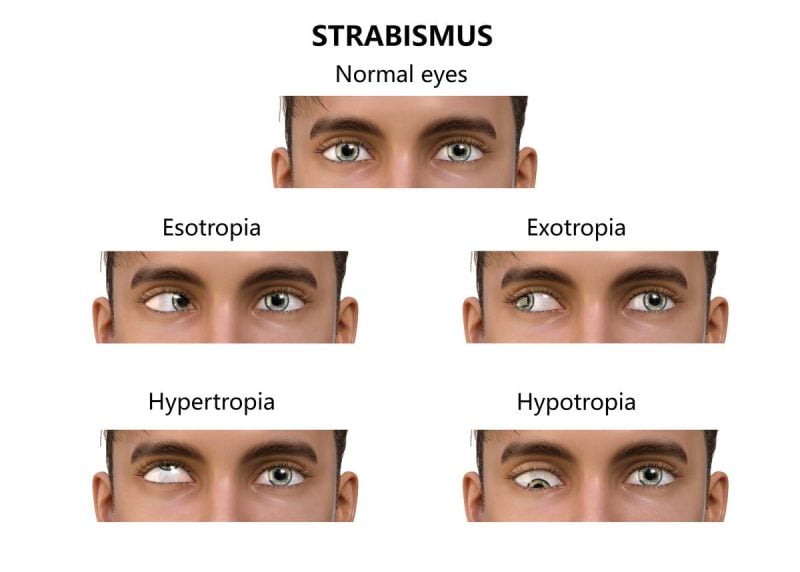Anisometropia is when one eye has a more severe refractive error than the other, leading to unequal vision. The term is pronounced as a-nuh-sow-muh-trow-pee-uh.
Refractive error, on the other hand, results from an imbalance between the eye’s light-focusing ability and its length, causing images to appear blurred on the retina. This condition is measured in diopters, representing the strength of glasses or contact lenses required to bring general ideas into focus on the retina.
Anisometropia is typically defined when the difference in corrective measures between the eyes exceeds one diopter.
What are the types of anisometropia?
There are six distinctive clinical types of anisometropia, each with its specific characteristics:
Simple Anisometropia
Simple anisometropia occurs when one eye has a normal vision (emmetropic) while the other eye is either nearsighted (myopic) or farsighted (hypermetropic). If one eye is myopic and the other is emmetropic, it is called simple myopic anisometropia.
On the other hand, if one eye is hypermetropic and the other is emmetropic, it is termed simple hypermetropic anisometropia or hyperopic anisometropia.
Compound Anisometropia
Compound anisometropia is when both eyes have the same vision problem, but the refractive error is significantly more severe in one eye than the other.
For instance, if both eyes are nearsighted, but one eye has much higher myopia than the other, it is known as compound myopic anisometropia.
Similarly, if both eyes are farsighted, but one eye has significantly higher hypermetropia, it is called compound hypermetropic anisometropia.
Mixed Anisometropia
Mixed anisometropia, also known as antimetropia, occurs when one eye is nearsighted, and the other is farsighted.
Simple Astigmatic Anisometropia
This type of anisometropia involves astigmatism, a vision problem caused by the irregular shape of the eye. With simple astigmatic anisometropia, one eye has normal vision, while the other eye has astigmatism along with either farsightedness or nearsightedness.
Compound Astigmatic Anisometropia
Compound astigmatic anisometropia occurs when both eyes have astigmatism, but one eye requires significantly more correction. In this type, both eyes are either farsighted or nearsighted.
Mixed Astigmatic Anisometropia
Mixed astigmatic anisometropia is characterized by astigmatism in both eyes, but one vision is farsighted while the other is nearsighted.
Who does anisometropia affect?
Anisometropia is a condition that can impact individuals of all ages. It may lead to amblyopia, commonly known as lazy eye, strabismus, and crossed eyes.
Amblyopia occurs when the brain prioritizes one eye over the other due to the difference in refractive error, leading to reduced vision in the weaker eye. Strabismus, conversely, results from the misalignment of the eyes, causing them to point in different directions.
Although relatively common, anisometropia can vary in its prevalence among the population, affecting approximately 28% of people.
Symptoms of anisometropia?
Detecting anisometropia in your child can be challenging since they may not vocalize vision issues. Unless you observe their eyes crossing or wandering, it may be noticed.
Typically, children won’t express that they have reduced vision in one eye compared to the other. The condition often comes to light during routine vision screenings or eye exams.
Minor discrepancies in refractive errors between their eyes may not initially lead to noticeable problems. However, if anisometropia remains untreated over time, symptoms might emerge, such as:
- Double vision (diplopia).
- Blurred vision.
- Headaches.
- Poor depth perception.
- Dizziness.
- Eye pain or discomfort.
What causes anisometropia?
The exact cause of anisometropia is not always clear, but it can result from various factors, including:
Genetic factors
Anisometropia may have a hereditary component, meaning it can run in families.
Differences in eye growth
During the development of the eyes in childhood, one eye might grow at a different rate or shape than the other, leading to a difference in refractive error.
Eye injury or surgery
Trauma or surgical interventions affecting one eye can cause a difference in the eye’s refractive power compared to the other.
Amblyopia
Anisometropia can be associated with amblyopia (lazy eye), where one eye has reduced visual acuity, leading to the brain favoring the stronger eye for vision.
Conditions affecting eye development
Certain conditions, such as cataracts or retinopathy of prematurity (ROP) in premature babies, can cause asymmetrical eye development and lead to anisometropia.
How is anisometropia diagnosed?
Anisometropia is diagnosed through a comprehensive eye examination conducted by an eye care professional, such as an optometrist or ophthalmologist. The diagnostic process typically involves the following steps:
Visual Acuity Test
This test assesses how well each eye can see individually by reading letters or symbols from a standardized eye chart. The eye care professional will measure visual acuity for near and distant vision.
Refraction Test
During a refraction test, the eye care professional uses a phoropter or trial lenses to determine the refractive error in each eye. It helps identify if there is a significant difference in the prescriptions between the two eyes.
Pupil Examination
The size and response of the pupils may be examined to check for any abnormalities or signs of neurological issues.
Binocular Vision Assessment
The eye care professional may perform tests to assess how well the two eyes work together as a team (binocular vision). It helps detect any issues related to eye alignment and coordination.
Ocular Health Examination
The eye care professional will examine the eyes’ health using various instruments and techniques, including a slit lamp and ophthalmoscopy. It helps rule out any other eye conditions or health issues affecting vision.
Cycloplegic Refraction (in children)
Cycloplegic refraction may be performed in young children. It involves using eye drops to temporarily relax the eyes’ focusing muscles, allowing a more accurate assessment of the refractive error.
It is essential to diagnose anisometropia early, especially in children, as it can lead to conditions like amblyopia (lazy eye) if left untreated.
Regular eye exams are crucial for detecting anisometropia and other vision problems, even without apparent symptoms. Early detection and proper management can ensure optimal vision and visual development.
How is anisometropia treated?
Treatment for anisometropia involves addressing the difference in eyesight between the affected eyes using eyeglasses, contact lenses, or surgical procedures.
In cases where amblyopia has developed (where one eye is weaker), treatment may focus on encouraging the brain to use the weaker eye more effectively. Effective strategies may include:
- They are patching the stronger eye to uplift the softer look to strengthen and develop better vision.
- Eye drops that blur the image in the stronger eye stimulate the brain to rely more on the weaker one.
- Utilizing filtered glasses that obstruct vision in the stronger eye prompts the brain to prefer the more fragile look.
By employing these treatments and techniques, individuals with anisometropia can enhance their vision and visual coordination, ensuring both eyes work harmoniously and provide more transparent, balanced eyesight.
Regular follow-ups and monitoring are essential to assess treatment progress and make any necessary adjustments for optimal results. If the condition is detected early and managed effectively, it can significantly improve the individual’s overall visual function and quality of life.
How can I prevent anisometropia?
Currently, there are no known methods to prevent refractive errors completely. These vision issues, such as nearsightedness (myopia), farsightedness (hyperopia), and astigmatism, can develop due to various factors, including genetics and age-related changes in the eye’s shape.
Despite advancements in eye care and vision correction, refractive errors remain inevitable in the human visual system.
However, there are specific measures that can promote eye health and potentially reduce the risk of worsening refractive errors:
Regular Eye Exams
Scheduling regular eye examinations with an optometrist or ophthalmologist can help detect refractive errors early and allow for timely correction.
Eye Health Awareness
Being aware of any changes in vision or experiencing symptoms like blurred vision, eye strain, or headaches can prompt seeking professional eye care promptly.
Limit Screen Time
Prolonged use of digital devices can strain the eyes and contribute to eye fatigue. Reducing screen time and taking breaks can alleviate eye strain.
Balanced Diet
Consuming a nutritious diet with eye-healthy nutrients like vitamins A, C, and E, omega-3 fatty acids, and zinc can support overall eye health.
Protective Eyewear
Wearing appropriate eyewear during sports or activities with a risk of eye injury can help prevent trauma that may affect vision.
Adequate Lighting
Ensuring proper lighting conditions when reading or working can reduce eye strain and visual discomfort.
No Smoking
Avoiding smoking or quitting can benefit overall health, including eye health.
While these practices cannot prevent the development of refractive errors, they contribute to maintaining good eye health and may slow the progression of specific vision issues.
Remember that refractive errors are common and can often be effectively managed with corrective eyeglasses, contact lenses, or refractive surgery to improve vision and enhance quality of life.
What can I expect if I have anisometropia?
The prognosis for anisometropia significantly improves when treatment is initiated at a young age. Early intervention can lead to better outcomes, and there is a good chance that your eyesight will stabilize, reducing the need for corrective lenses.
However, for older children and adults, the likelihood of requiring continued use of corrective lenses is higher. In such cases, wearing glasses or contact lenses remains a common and effective way to manage anisometropia and achieve more precise vision.
Regular vision check-ups and consultations with eye care professionals are essential to ensure proper monitoring and the most appropriate treatment for your visual needs.
When should I see my healthcare provider?
Should you notice your child squinting or suspect any issues with their vision, it is essential to reach out to your healthcare provider promptly.
Early detection of vision problems allows for timely intervention and treatment, ensuring the best possible outcome for your child’s visual health. Feel free to seek professional advice to address concerns and provide your child’s eyesight is well-cared for.
Conclusion
Maintaining good vision is crucial for overall health. Like any other medical issue, early detection and treatment of eye conditions are vital. Regular vision tests for young children and adults are essential to identify any problems promptly.
Corrective lenses, such as glasses and contact lenses, can effectively address refractive errors and offer clear vision. Corrective lenses are an effective treatment option for anisometropia to improve visual clarity and enhance eye health.






